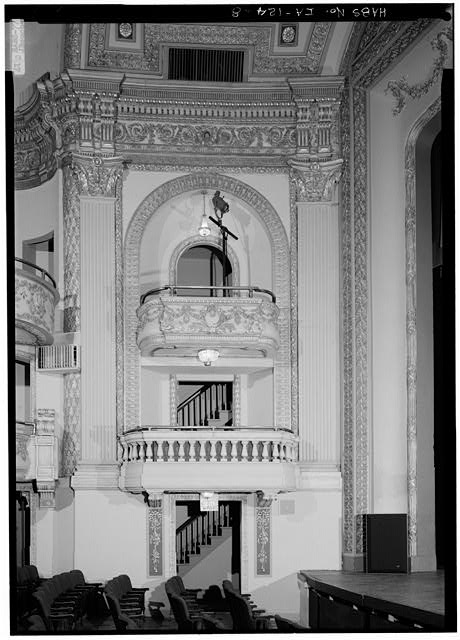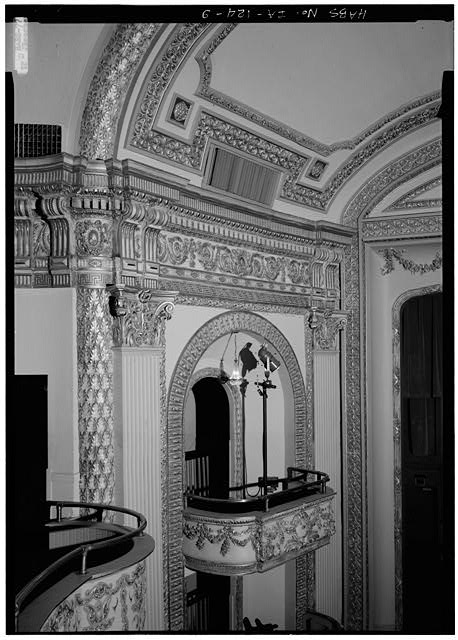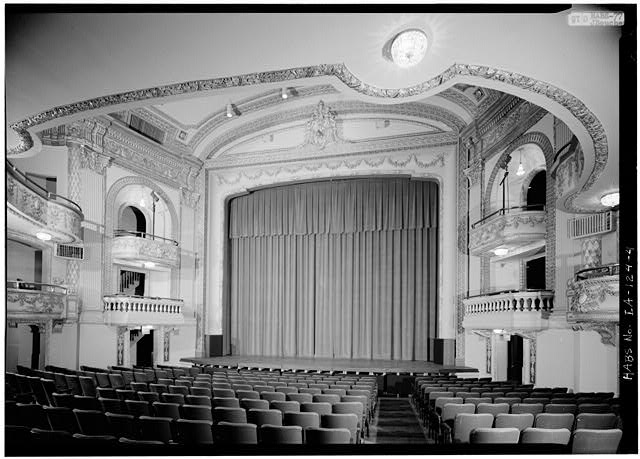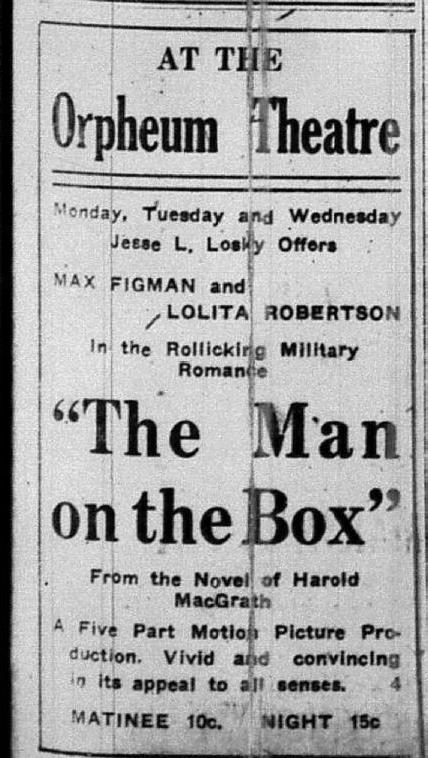Encyclopedia Dubuque
"Encyclopedia Dubuque is the online authority for all things Dubuque, written by the people who know the city best.”
Marshall Cohen—researcher and producer, CNN
Affiliated with the Local History Network of the State Historical Society of Iowa, and the Iowa Museum Association.
ORPHEUM: Difference between revisions
No edit summary |
No edit summary |
||
| Line 35: | Line 35: | ||
Led by Norman and representatives of the [[DUBUQUE CHAMBER OF COMMERCE]], U. S. Re. [[CULVER, John|John CULVER]] toured the Orpheum in October, 1971. By then the concept of restoring the theater and constructing a complete exhibition center adjoining it at 5th and Main had grown popular among local business leader and civic officials. Culver pledged he would look into the possibility of federal aid for the estimated $1.3 million project. Possibilities, he believed, lay in the Department of Housing and Urban Development and the National Preservation Act. (1) | |||
Proposals to aid were presented to Iowa Governor Robert Ray; Murray Goodman, Iowa Director of the American Bicentennial Commission (ARBC); and Del Black, regional director of ARBC. Each endorsed the idea, but offered no money. In February, 1973 a delegation including Wayne Norman, Five Flags chairman; Mayor _____, a county supervisor and 24 Five Flags committeemen flew to Washington, D.C. On their invitation list to see a presentation on the project were the entire Iowa congressional delegation, officials from Housing and Urban Development, representatives from the departments of Interior, Health, Education and Welfare, National Trust for Historic Preservation, ARBC, and the Bureau of Parks and Recreation. Their theme was a multi-media theater wold depict the development of the Upper Midwest and its importance to the nation beginning with the adventures of [[CARDINAL, Jean Marie|Jean Marie CARDINAL]]. According to their plan, the entire center in 1976 would be devoted to the bicentennial with frontier exhibits, multi-media theater, and perhaps a commissioned play. After that, the center would serve the tri-states. Their appeal was for $1.4 million--two-thirds of the $2.1 million need to refurbish the Orpheum and construct the civic center. (2) | |||
By 1969 the Orpheum along with much of the area around Lower Main Street was suffering disastrous economic times. The theater was scheduled for demolition as part of a fifteen-block [[URBAN RENEWAL]] project. Led by such community activists as [[NORMAN, Wayne Andrew Sr.|Wayne Andrew NORMAN, Sr.]], a group developed the idea that private donations could be collected to renovate the theater into part of an exhibition-arts facility. The project was named for the five national flags that have flown over this area. | By 1969 the Orpheum along with much of the area around Lower Main Street was suffering disastrous economic times. The theater was scheduled for demolition as part of a fifteen-block [[URBAN RENEWAL]] project. Led by such community activists as [[NORMAN, Wayne Andrew Sr.|Wayne Andrew NORMAN, Sr.]], a group developed the idea that private donations could be collected to renovate the theater into part of an exhibition-arts facility. The project was named for the five national flags that have flown over this area. | ||
In December 1971 the fund drive was launched. With its success, architects were hired in July, 1972 to design the facility. In November 1972, the Orpheum Theater was placed on the [[NATIONAL REGISTER OF HISTORIC PLACES]]. The theater was restored in 1975, renamed the Five Flags Theater and reopened on February 28-29, 1976. With restoration, the main floor seated 322; the balcony, 357; and the boxes, 38 for a total of 717 people. The theater has been used annually for performances of the [[DUBUQUE SYMPHONY ORCHESTRA]]. | |||
On August 17, 1976, an overwhelming 70% of the voters approved a bond referendum for the construction of the [[FIVE FLAGS CIVIC CENTER]]. Besides the arena, which covered 27,000 square feet of floor space and seats up to 4,000, the new plan called for theater support rooms, locker rooms, storage space, and administrative offices. The complex was connected to and designed to complement the restored theater. The new civic center opened its doors in 1979. | On August 17, 1976, an overwhelming 70% of the voters approved a bond referendum for the construction of the [[FIVE FLAGS CIVIC CENTER]]. Besides the arena, which covered 27,000 square feet of floor space and seats up to 4,000, the new plan called for theater support rooms, locker rooms, storage space, and administrative offices. The complex was connected to and designed to complement the restored theater. The new civic center opened its doors in 1979. | ||
| Line 45: | Line 49: | ||
Source: | Source: | ||
1. "Culver Looks to Orpheum Aid," ''Telegraph-Herald'', October 31, 1971, p. 8 | |||
2. Brimeyer, Jack. "Dubuquers to Push Five Flags Plan Tomorrow in Washington," ''Telegraph-Herald'', February 25, 1973, p. 12 | |||
Revision as of 02:51, 25 January 2018
ORPHEUM THEATRE. In 1961 Nicholas J. YIANNIAS was assistant manager of ASSOCIATED THEATRES which included the Orpheum Theater, GRAND THEATRE, STATE THEATRE and STRAND THEATER.

Led by Norman and representatives of the DUBUQUE CHAMBER OF COMMERCE, U. S. Re. John CULVER toured the Orpheum in October, 1971. By then the concept of restoring the theater and constructing a complete exhibition center adjoining it at 5th and Main had grown popular among local business leader and civic officials. Culver pledged he would look into the possibility of federal aid for the estimated $1.3 million project. Possibilities, he believed, lay in the Department of Housing and Urban Development and the National Preservation Act. (1)
Proposals to aid were presented to Iowa Governor Robert Ray; Murray Goodman, Iowa Director of the American Bicentennial Commission (ARBC); and Del Black, regional director of ARBC. Each endorsed the idea, but offered no money. In February, 1973 a delegation including Wayne Norman, Five Flags chairman; Mayor _____, a county supervisor and 24 Five Flags committeemen flew to Washington, D.C. On their invitation list to see a presentation on the project were the entire Iowa congressional delegation, officials from Housing and Urban Development, representatives from the departments of Interior, Health, Education and Welfare, National Trust for Historic Preservation, ARBC, and the Bureau of Parks and Recreation. Their theme was a multi-media theater wold depict the development of the Upper Midwest and its importance to the nation beginning with the adventures of Jean Marie CARDINAL. According to their plan, the entire center in 1976 would be devoted to the bicentennial with frontier exhibits, multi-media theater, and perhaps a commissioned play. After that, the center would serve the tri-states. Their appeal was for $1.4 million--two-thirds of the $2.1 million need to refurbish the Orpheum and construct the civic center. (2)
By 1969 the Orpheum along with much of the area around Lower Main Street was suffering disastrous economic times. The theater was scheduled for demolition as part of a fifteen-block URBAN RENEWAL project. Led by such community activists as Wayne Andrew NORMAN, Sr., a group developed the idea that private donations could be collected to renovate the theater into part of an exhibition-arts facility. The project was named for the five national flags that have flown over this area.
In December 1971 the fund drive was launched. With its success, architects were hired in July, 1972 to design the facility. In November 1972, the Orpheum Theater was placed on the NATIONAL REGISTER OF HISTORIC PLACES. The theater was restored in 1975, renamed the Five Flags Theater and reopened on February 28-29, 1976. With restoration, the main floor seated 322; the balcony, 357; and the boxes, 38 for a total of 717 people. The theater has been used annually for performances of the DUBUQUE SYMPHONY ORCHESTRA.
On August 17, 1976, an overwhelming 70% of the voters approved a bond referendum for the construction of the FIVE FLAGS CIVIC CENTER. Besides the arena, which covered 27,000 square feet of floor space and seats up to 4,000, the new plan called for theater support rooms, locker rooms, storage space, and administrative offices. The complex was connected to and designed to complement the restored theater. The new civic center opened its doors in 1979.
---
Source:
1. "Culver Looks to Orpheum Aid," Telegraph-Herald, October 31, 1971, p. 8
2. Brimeyer, Jack. "Dubuquers to Push Five Flags Plan Tomorrow in Washington," Telegraph-Herald, February 25, 1973, p. 12





